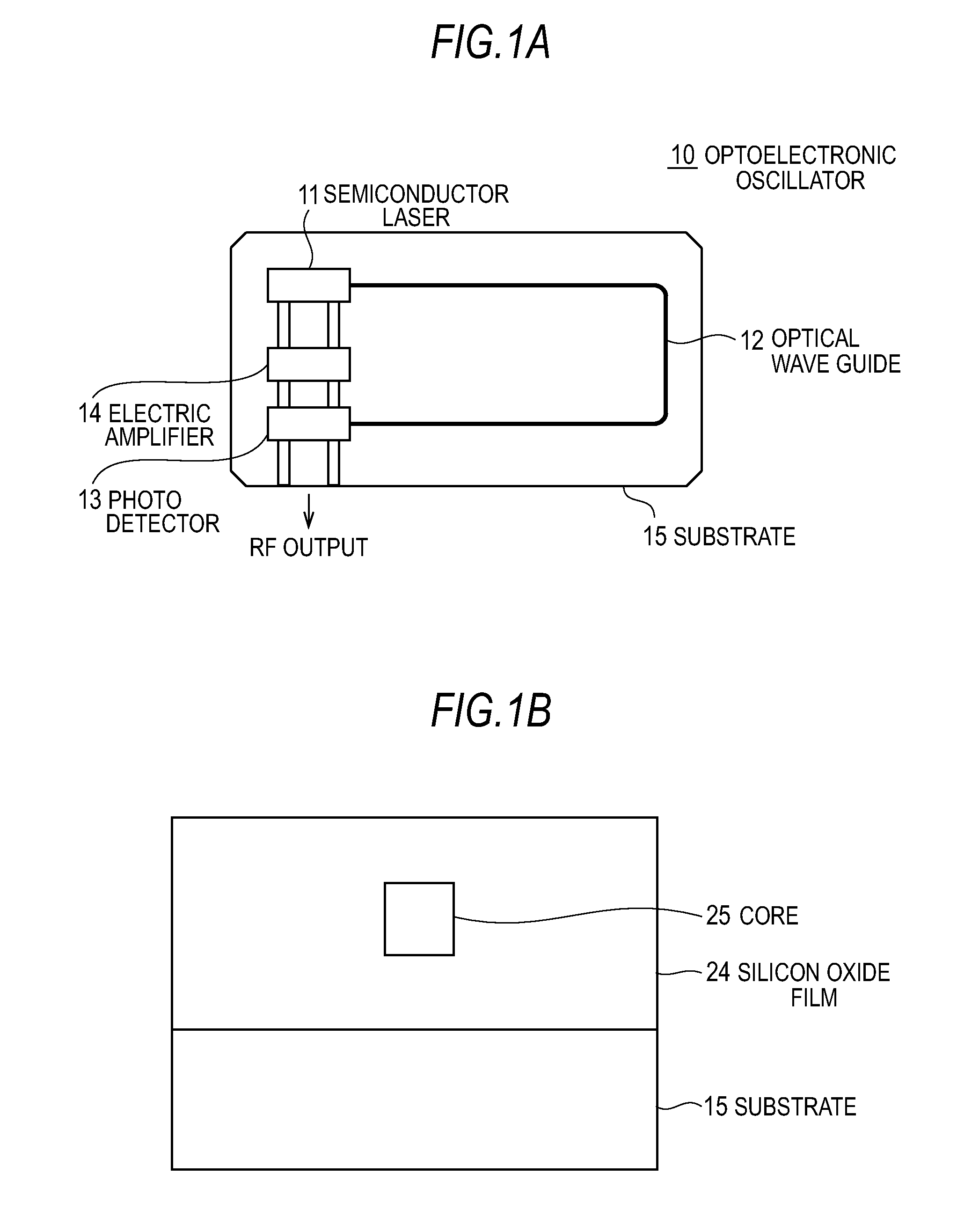Optoelectronic oscillator and pulse generator
- Summary
- Abstract
- Description
- Claims
- Application Information
AI Technical Summary
Benefits of technology
Problems solved by technology
Method used
Image
Examples
first embodiment
The First Embodiment
[0060]FIG. 1(a) shows an optoelectronic oscillator (hereinafter might be only called an oscillator) of the first embodiment of the present invention and FIG. 1(b) shows the section of an optical waveguide used in the optoelectronic oscillator. An oscillator 10 comprises a semiconductor laser (DFB laser) 11 as active element, a SiO2-system optical waveguide 12 as an optical delay circuit, a photodetector 13 containing InP compound semiconductor, and an amplifier 14 having a CMOS FET and constituent elements of the oscillator 10 are integrated on silicon substrate 15. As shown in FIG. 1(b), a silicon oxide film (SiO2) 24 is formed on a surface of the silicon substrate 15, in this silicon oxide film 24 germanium oxide (GeO2) is doped and a core 25 of the optical waveguide 12 is formed. In the present embodiment, the SiO2-system optical waveguide 12 is formed with embedded structure.
[0061]The DFB laser 11 is a semiconductor laser having oscillation wavelength of 1.55...
second embodiment
The Second Embodiment
[0066]The second embodiment of the present invention is applied to the process to manufacture the optoelectronic oscillator of the above described first embodiment. An optoelectronic oscillator monolithically forms a semiconductor laser, an optical waveguide and a photodetector on a compound semiconductor substrate such as InP. In the manufacture process, an active element part including active layer that will be a laser or a photodetector and a passive part that will be an optical waveguide are formed using butt joint growth method, for instance. The laser part and the photodetector constituting the active element part can be formed with embedded structure. Furthermore, the active layer uses 6 layers quantum well structure. The laser and the photodetector have the structures similar to the first embodiment. Furthermore, the optical waveguide part is formed with high mesa structure and its core, for instance, is formed with InGaAsP, and its thickness is 0.3 μm a...
third embodiment
The Third Embodiment
[0067]The third embodiment of the present invention is applied to the process to manufacture the optoelectronic oscillator of the above described first embodiment. The optoelectronic oscillator forms a laser and a photodetector on a SiO2-substrate by hybrid integration technology. In the manufacture process, a SiO2-substrate is formed through thermal oxidization of silicon and, for instance, high mesa waveguide of silicon is formed on the SiO2-substrate. High mesa structure is formed by RIE (Reactive Ion Etching) method using electron beam resist as a mask. For instance, its mesa depth is 0.2 μm and its mesa width is 1 μm, wave length, and the structure that it propagates in single mode at 1.55 μm is adopted. A semiconductor laser and a photodetector are aligned using active alignment or passive alignment technology using cross-shaped alignment mark and fixed on the SiO2-substrate using AuSn solder.
PUM
 Login to View More
Login to View More Abstract
Description
Claims
Application Information
 Login to View More
Login to View More - R&D
- Intellectual Property
- Life Sciences
- Materials
- Tech Scout
- Unparalleled Data Quality
- Higher Quality Content
- 60% Fewer Hallucinations
Browse by: Latest US Patents, China's latest patents, Technical Efficacy Thesaurus, Application Domain, Technology Topic, Popular Technical Reports.
© 2025 PatSnap. All rights reserved.Legal|Privacy policy|Modern Slavery Act Transparency Statement|Sitemap|About US| Contact US: help@patsnap.com



